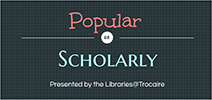Knowing how to tell a scholarly resource from a popular one can help you find the best resources for your research projects and papers.
Scholarly Resources:
- Often referred to as academic or peer-reviewed journals and articles.
- For books, you should easily find qualified reviews (New York Times Review of Books, Choice, Kirkus Reviews).
- More comprehensive writing as they are written for professionals in the field.
- Illustrations in articles are limited to tables and graphs.
- Citations throughout of other works on the subject.
- Any research conducted contains all methodologies and experiments conducted.
Popular Resources:
- Magazines, newspapers, blogs, websites, social media are popular sources.
- Written for general audience so they can be understood by anyone.
- Many graphics, pictures, photographs or other illustrations.
- Advertisements, website cookies, social plugins or third party apps.
- Sources not always mentioned or may be anonymous and are never cited.
- Research or study information is not provided in full or is not linked.


